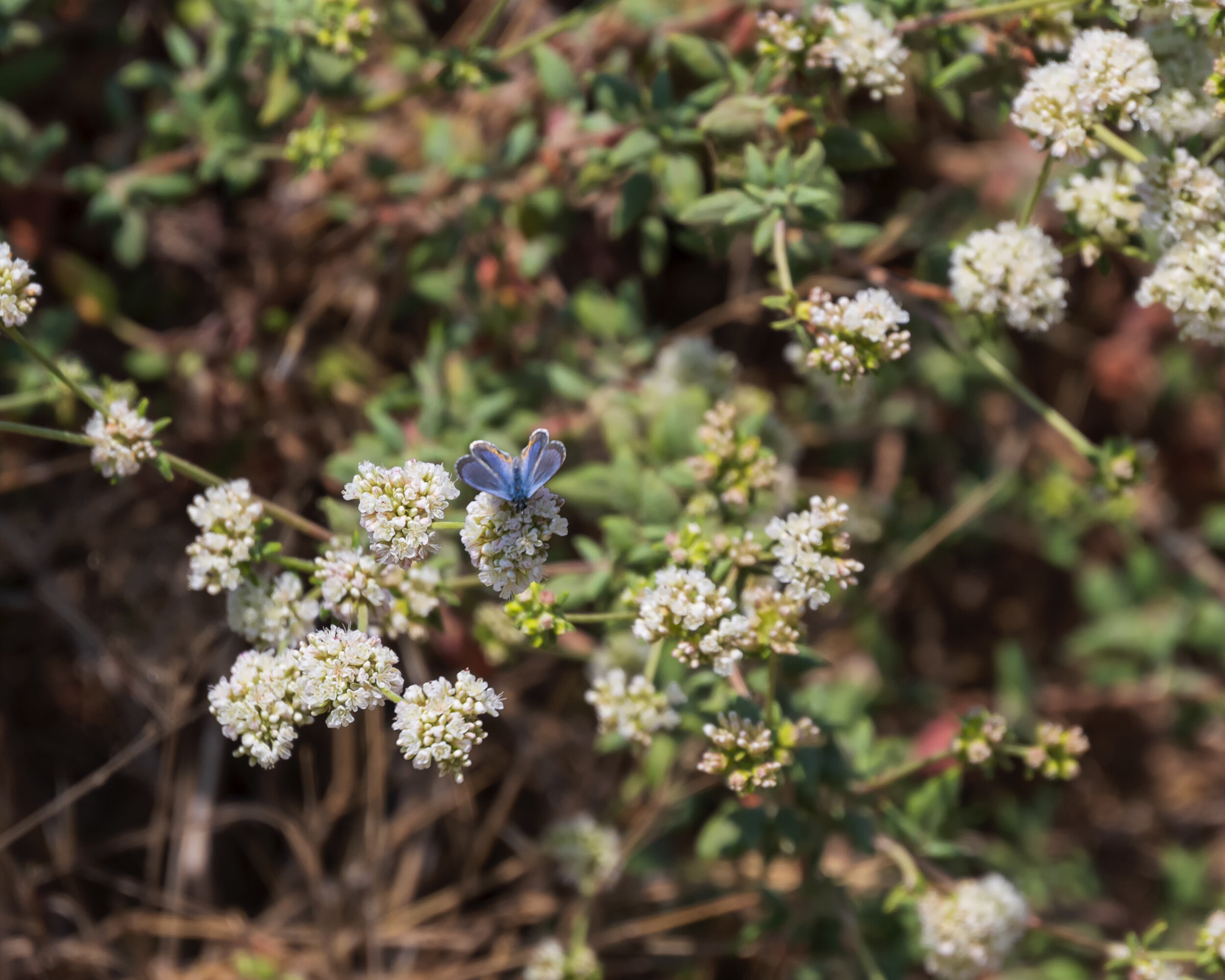The El Segundo Blue Butterfly ~ A Fight for Survival By Steve Tabor
The El Segundo Blue Butterfly ~ A Fight for Survival
By Steve Tabor
Once these tiny, winged insects populated the coastal areas where species of buckwheat commonly known as Sea Cliff Buckwheat (Eriogonum parvifolium) thrived. At one time, the 3,200 acres of the El Segundo Sand Dunes near Los Angeles International Airport was believed to have supported a population of nearly 750,000 of these tiny creatures.
El Segundo blue butterflies (ESB) (Euphilotes allyni) are completely dependent on coastal Sea Cliff Buckwheat to maintain their population. Adult butterflies typically emerge between mid-June through early September. They depend on the nectar and pollen of the Sea Cliff Buckwheat to maintain their life cycle. Adult ESB live for a period as short as four days, but seldom extend beyond two weeks. During that time, the female butterflies deposit their eggs in the buckwheat flowers. When eggs hatch in three to five days, the caterpillars (larvae) undergo four phases of molting before becoming pupa which lay in the leaf litter, sand, or at the base of the buckwheat leaves. The pupa hibernates until it emerges as an adult butterfly in the following year.
In the late 1970s, coastal development severely jeopardized the ESB population. The coastal sand dunes and buckwheat fell victim to housing and commercial development. As a result, the ESB population was so negatively impacted that the butterflies were added to the Endangered Species list. In the 1980s, habitat restoration efforts began taking place along the South Bay coast in areas that could be protected from urban growth and could also provide a suitable environment for buckwheat and the ESB. Today, the ESB are now found in Los Angeles County extending from the Palos Verdes Peninsula north to the Ballona Wetlands and in Santa Barbara County.
To assist in the efforts to restore the ESB population, the Palos Verdes Peninsula Land Conservancy (Conservancy) has undertaken habitat restoration throughout multiple reserves on the Palos Verdes Peninsula including Alta Vicente, Abalone Cove Reserve and Vicente Bluffs Reserve near the Point Vicente Interpretive Center. Planting buckwheat in selected areas of these locations, the Conservancy provides the specific environment needed by the ESB to maintain its life cycle and continue to increase in population.
According to Cynthia Woo, a veteran volunteer for the Conservancy at the ESB restoration site in the Vicente Bluffs Reserve, spotting these creatures can be a bit of a challenge but possible if you look closely. Woo indicates the best viewing is on warmer sunny days when there is nothing more than a slight breeze. Generally, you will not see more than one or two butterflies at a time. Their small size, approximately 0.8 inches to 1.0 inch in length with a similar size wingspan can make them very difficult to spot. Adding to the challenge, only the males have the trademark bright blue wings, while the females have muted grey-blue wings. They spend much of their time erratically flying about the buckwheat plants and only briefly landing on the plant before becoming airborne again. When they come to rest on the buckwheat, they often fold their wings and blend into the vegetation.
The key to the recovery of the ESB is expanding the areas including home gardens with the host plant buckwheat that is grown in the Conservancy’s Native Plant Nursery. To help the ESB and other pollinators experiencing habitat loss, the Conservancy has a new Butterfly Basket available for pre-order online at https://pvplc.org/plant-sales/. The Spring Basket includes Sea Cliff Buckwheat (Eriogorum parvifolium), Wishbone Bush (Mirabilis laevis), Bladderpod (Peritoma arborea) and Lupine (Lupinus ssp.) that will be available for pickup in time for Spring planting in March. The cost is $40 for these four special native plants.
The Conservancy also has several nature walks to visit ESB sites throughout the year which you can find at https://pvplc.org/calendar-guided-nature-walks/.
Sources:
The Palos Verdes Peninsula Land Conservancy
U.S. Fish and Wildlife Service
Urban Wildlands
Center for Biological Diversity
Essig Museum of Entomology, UC Berkeley
Steve Tabor Bio
This South Bay native’s photographic journey began after receiving his first 35 mm film camera upon earning his Bachelor of Arts degree. Steve began with photographing coastal landscapes and marine life. As a classroom teacher he used photography to share the world and his experiences with his students. Steve has expanded his photographic talents to include portraits and group photography, special event photography as well as live performance and athletics. Steve serves as a volunteer ranger for the Catalina Island Conservancy and uses this opportunity to document the flora and fauna of the island’s interior as well as photograph special events and activities.
Watch for Steve Tabor Images on the worldwide web.





















